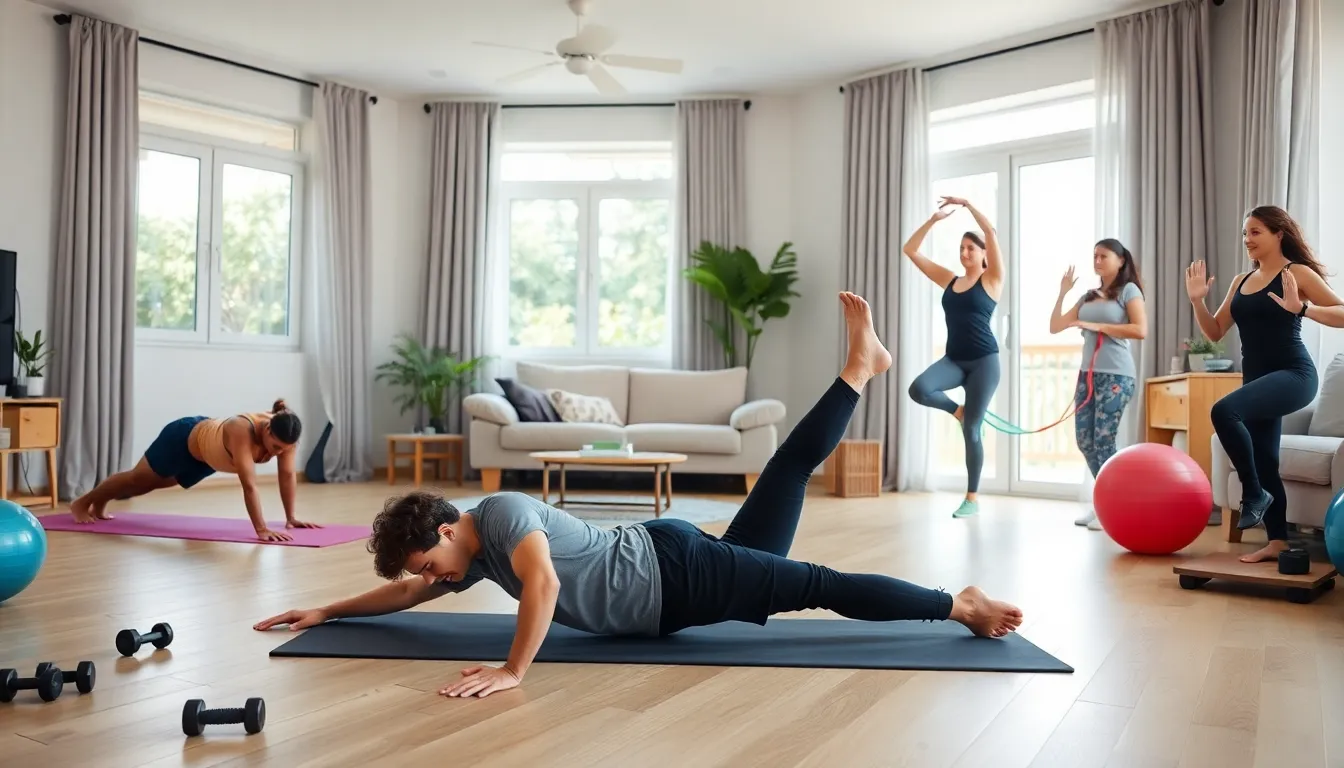In today’s fast-paced world, finding time to hit the gym can feel impossible. Fortunately, home exercises offer a convenient and effective way to stay fit without stepping outside. With just a small space and minimal equipment, anyone can transform their living room into a personal workout haven.
These exercises not only save time but also cater to various fitness levels and goals. Whether someone wants to build strength, improve flexibility, or boost cardiovascular health, there’s a home workout for everyone. By incorporating simple routines into daily life, individuals can enjoy the benefits of regular exercise while maintaining their comfort and privacy. Embracing home workouts can lead to a healthier lifestyle and a more balanced routine.
Table of Contents
ToggleBenefits Of Home Exercises
Home exercises offer numerous benefits, making them an ideal choice for busy individuals. From convenience to cost savings, these workouts create effective solutions tailored to personal lifestyles.
Convenience And Accessibility
Home exercises provide unmatched convenience, allowing individuals to work out at any time. They eliminate travel time to the gym and reduce scheduling conflicts. Additionally, home workouts accommodate various fitness levels and goals, from beginner routines to advanced challenges. They create a flexible environment, enabling individuals to customize their workout schedules.
Cost-Effectiveness
Home exercises significantly reduce fitness expenses. They eliminate gym memberships and commuting costs, offering a budget-friendly alternative. Many effective workouts require minimal or no equipment, such as bodyweight exercises. Individuals can access a wealth of free online resources, like videos and tutorials, promoting a cost-effective approach to fitness.
Types Of Home Exercises

Home exercises encompass a range of workouts designed to improve overall fitness. They can be categorized into strength training, cardio workouts, and flexibility and stretching routines.
Strength Training
Strength training focuses on building muscle and improving endurance. Common exercises include:
- Bodyweight Exercises: Squats, push-ups, and lunges target various muscle groups without any equipment.
- Resistance Band Workouts: Bands offer versatile resistance for exercises like bicep curls and shoulder presses.
- Dumbbell Routines: Dumbbells provide targeted strength training for the arms, chest, and back with exercises such as tricep extensions and bent-over rows.
Cardio Workouts
Cardio workouts enhance cardiovascular health and boost metabolic rates. Effective home cardio exercises feature:
- High-Intensity Interval Training (HIIT): Short bursts of intense activity, such as burpees or jumping jacks, alternated with brief rest periods maximize calorie burn.
- Circuit Training: Combining multiple exercises (e.g., jumping rope, mountain climbers) into a circuit maintains an elevated heart rate.
- Dance and Aerobics: Engaging sessions that incorporate dance moves or step routines provide a fun way to improve aerobic fitness.
Flexibility And Stretching
- Dynamic Stretching: Incorporating movements like leg swings or arm circles prepares the body for workouts.
- Static Stretching: Holding stretches such as hamstring or quad stretches post-workout promotes muscle recovery.
- Yoga and Pilates: These disciplines improve flexibility, core strength, and overall body awareness through a series of controlled movements and poses.
Designing An Effective Home Exercise Routine
Designing an effective home exercise routine involves strategic planning and personalization. Individuals can enhance their fitness journey by setting clear goals and creating a consistent schedule.
Setting Goals
Setting specific, measurable, achievable, relevant, and time-bound (SMART) goals helps maintain motivation and focus. Individuals may set weight loss targets like losing 5 pounds in a month or performance targets such as completing a 30-minute HIIT workout without breaks. Tracking progress through apps or journals fosters accountability, facilitating adjustments to routines to ensure continuous improvement.
Creating A Schedule
Creating a schedule promotes consistency and habit formation. Individuals may choose to allocate 30 minutes, three to five times a week for their workouts. Incorporating rest days allows for muscle recovery, essential for strength gains. Utilizing a planner helps visualize workout sessions, making it easier to integrate workouts into daily routines. Highlighting preferred times, such as early mornings or evenings, ensures workouts fit seamlessly into individual lifestyles, increasing adherence to the routine.
Common Mistakes To Avoid
Home exercises offer great flexibility, but certain mistakes can hinder effectiveness and lead to injury.
Not Warming Up
Not warming up can significantly increase the risk of injury and decrease workout performance. Skipping this crucial step causes muscles and joints to remain stiff, impairing movement efficiency. A proper warm-up, lasting 5 to 10 minutes, activates the cardiovascular system and prepares muscles for exertion. Dynamic stretches like leg swings and arm circles, as well as light aerobic activities such as jogging in place, enhance blood flow and elevate body temperature. Ignoring warm-ups can result in strains or sprains, ultimately derailing fitness progress.
Overtraining
Overtraining occurs when individuals engage in excessive exercise without allowing adequate recovery. Symptoms include persistent fatigue, decreased performance, and increased risk of injuries. Home workouts are often less structured, leading many to underestimate the importance of rest days. Implementing a balanced routine that includes rest days and lower intensity workouts prevents burnout and promotes muscle recovery. Scheduling workouts to include variety and listening to one’s body for signs of fatigue provide essential opportunities for healing and adaptation, enabling long-term fitness success.
Tips For Staying Motivated
Staying motivated during home workouts requires strategic approaches and practical techniques. Utilizing variety and tracking progress are two key methods to maintain enthusiasm and drive.
Incorporating Variety
Incorporating variety into workout routines prevents boredom and sustains interest. Rotate different types of exercises through the following methods:
- Mixing Up Exercises: Combine strength training, cardio, and flexibility routines to create well-rounded workouts.
- Changing Environments: Occasionally workout in different areas of the home, such as the backyard or living room, to enhance the experience.
- Adjusting Intensity Levels: Experiment with varying intensity by increasing repetitions, resistance, or workout duration to stimulate progress.
- Exploring New Workouts: Try new platforms or apps that offer diverse workout styles and challenges, including dance, kickboxing, or yoga classes.
Tracking Progress
- Setting Specific Goals: Set measurable goals for each workout session, such as targets for repetitions or duration.
- Using Fitness Apps: Leverage fitness tracking apps to log workouts, monitor achievements, and visualize progress over time.
- Maintaining a Workout Journal: Write down workouts, feelings, and milestones in a journal to reflect on improvements and maintain focus.
- Regular Assessments: Schedule regular fitness assessments, such as timed runs or strength tests, to measure progress and adjust goals accordingly.
Home exercises offer a practical solution for those juggling busy schedules. With the right approach anyone can transform their living space into a personal fitness haven. By embracing the flexibility and cost-effectiveness of home workouts individuals can achieve their fitness goals without the constraints of a gym environment.
Incorporating a variety of exercises not only keeps routines fresh but also enhances motivation. With careful planning and attention to personal needs anyone can enjoy the numerous benefits that come from exercising at home. Ultimately a commitment to regular physical activity fosters a healthier lifestyle while providing the comfort and convenience that modern life demands.




